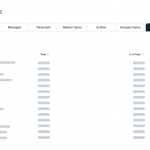Real-Time Adherence – the art of smarter scheduling
Real-Time Adherence – the art of smarter scheduling

Learn how to be a smooth operator using automated Workforce Management technology. Nick Brook at Calabrio shares 7 golden rules for releasing the benefits of Real-Time Adherence for smarter scheduling.
Life is tough for workforce management (WFM) teams. Employees call in sick or run late to their shift, the latest promotional marketing campaign is so successful that product demand and call volumes are going through the roof or demand drops and too many employees are hanging around waiting to handle enquiries. The mere thought of managing it all while accommodating shift preferences, part-time workers and shift swaps is enough to bring on a headache even before the first cup of morning coffee.
By far the biggest gripe is having to handle last-minute time-off requests with 55% of contact center professionals complaining about the issue. Even more worrying is that several factors are set to make matters worse. A 2018 Call Center Helper survey revealed that only 52.3% of organizations have deployed an automated WFM system with one in ten contact centers still relying on either pen and paper or whiteboards to schedule staff while low employee numbers continue to act as a hurdle to providing great customer service, rising from 24.5% to 30% since 2015.
Take the final leap into the cloud with Real-Time Adherence
Managing today’s multi-channel contact centers is actually easier than you might think with a little forward-planning and the right technology. If nothing else encourages that final leap into the cloud, perhaps the benefits of Real Team Adherence (RTA) will. Use the latest automated solutions for:
- Flexible planning ‘on the go’ – RTA technology monitors agent adherence to schedules and compares them with the live ACD status. Automated alarms flag up when schedules are in danger of being breached and a real-time data feed, updated in seconds, enables fast decision-making
- Add intra-day schedulers to the mix and reschedule the workforce during the day. Unplanned changes in customer demand and last-minute agent absences are overcome because break times, lunches and even the deployment of people between different skills groups can be accommodated in a matter of minutes. The changes might only be small but they can make all the difference between meeting service levels during peak periods and losing valuable contacts and customers – forever
- Business continuity planning – automated RTA solutions give organizations all they need to prepare for the unexpected such as storms that prevent people from getting to the office or major systems outages. High visibility of dynamic data makes tracking agent adherence and adjusting schedules to maintain service levels easier. Graphics make it possible to spot developing trends as they happen to facilitate fast re-forecasting or last-minute optimization
- Complete control now and in the future – make WFM technology a highly valuable planning tool. Running a series of ‘what if’ scenarios can predict staffing needs for regular seasonal fluctuations like Christmas, upcoming new marketing campaigns and even right-size the contact center to support your organization’s long-term business and expansion programs.
Seven golden rules for smarter scheduling
Before making changes take a step back and learn from the mistakes of experienced WFM users. Here are the golden rules:
- Respect the past – history is always relevant. Access to accurate data along with a recorded audit trail of previous forecasting activities provides a solid foundation for future forecasts.
- Accept that change is the only constant – factor channels, agent preferences, and unplanned absences into forecasts. That way, the contact center is always ready to react to the unexpected swiftly and effectively.
- Never work in isolation – make sure planning teams work with other parts of the business to improve forecasting. Make it your business to know about promotions and advertising campaigns so when those enquiries come in and customer service is ready for action.
- Schedule administrative tasks and training during quiet times – and let employees give their full attention to the customer during busy periods.
- Add ‘travel time’ into schedules – for example, adding a cushion of 5 minutes either side of a 30-minute training session will make it easy for everyone to arrive on time without running and adhere to their schedules.
- Flatten the spikes – don’t forget the ‘out of the ordinary’ events that can adversely impact the efficiency of the contact center such as systems outages, negative comments on social media or news in the press. Be sure to factor these into the WFM equation.
- Aim for continuous improvement – processes require constant re-evaluation to increase efficiencies and gain a competitive edge. Reviewing processes and historical data should be a regular diary date, at a set time of the week and at least once a month.
Act now to stop that niggling headache turning into a full-blown migraine. Don’t rush in, take a considered, pragmatic approach and work with the right technology partner to keep your contact center running smoothly and at peak performance.









